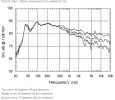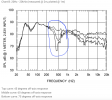The percentages are totally subjective and dependent on the way one views these percentages. Logarithmic? Linear? From the way I view these things, saying the LS50M + subs is only 40% as good seems rather silly, but I tend to view this question different than most, or so it seems. For me 0% as good would be it doesn't produce sound at all. Ignoring dynamics(which is a big part of where extra cost is justified) 50-60% would be like internal TV speakers. More than half of the sound quality is there. You can watch TV and understand dialogue, all your music sounds like your music, just with less bass, and less refinement. For me, a JBL 308p is probably 80-85%+ as good as the best there is. Going from TV speakers to JBL 308p is a bigger leap than going from the 308p to the M2. Outside of dynamics and bass, I just haven't heard anything that's (what I would call) "way better" than a good neutral, budget loudspeaker.
I know that by far the biggest jump in sound quality I've ever experienced was when I went from TV speakers to my Infinity Beta 20 setup. That was more of an improvement than the jump from the Infinity Beta 20 to Genelec 8351 is. If I A/Bed the two against each other, I bet most non audiophiles would say something like "the Genelec sounds a little better, but they both sound amazing".
Like I said, though, I think I have a different scale(more linear?). Just the way I think about it I suppose. I had several people message me a few months ago asking why I said the 8351b was only 5-10%(at most) better(ignoring bass and dynamics) than the 8030c

. I can see why by some different scale that might seem weird. I tend to think this hobby is more or less all about squeezing out that last 10%

. I'm fine with it, though. It's comparable to other expensive hobbies. A SOTA road bike might knock a few seconds off your mile time (~1-5%?) over a good bike, but it's not gonna get you a 50-60% improvement.



